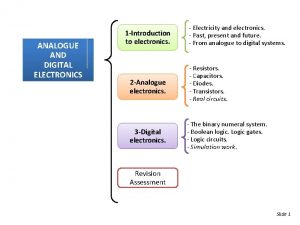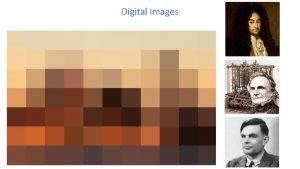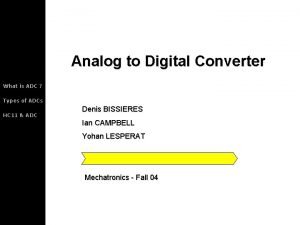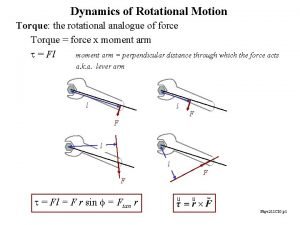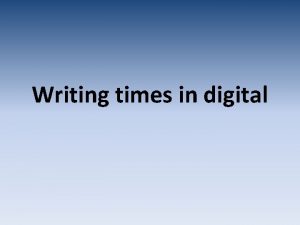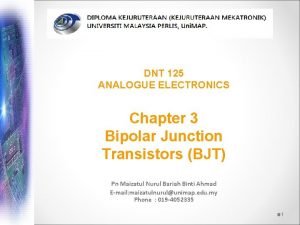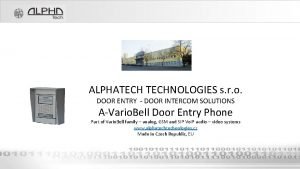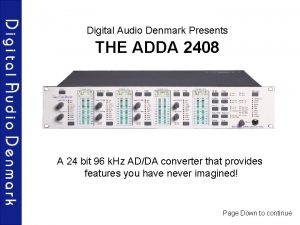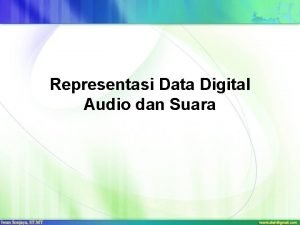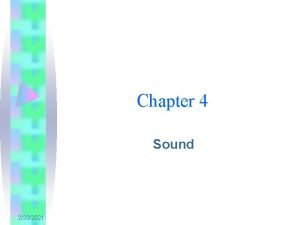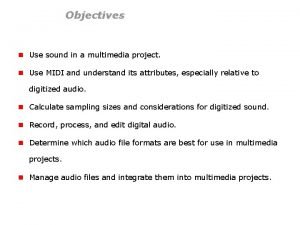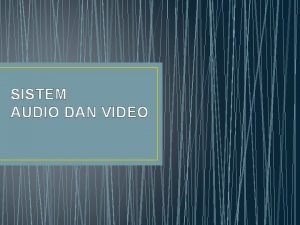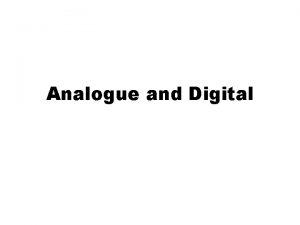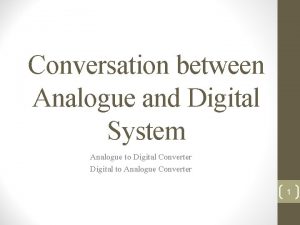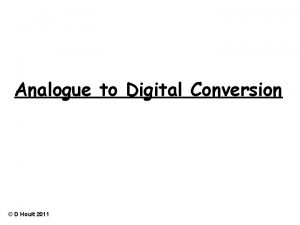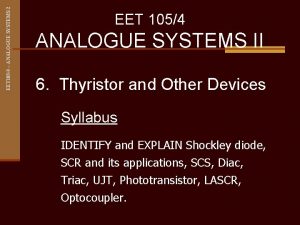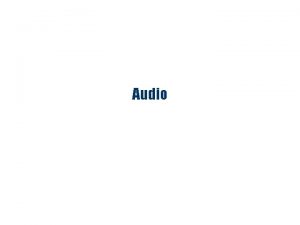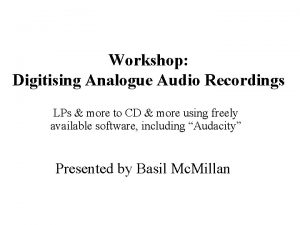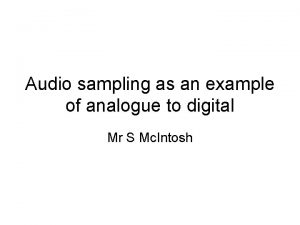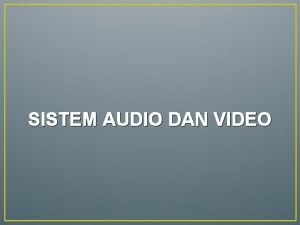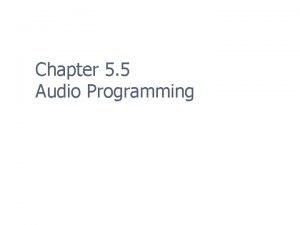Digital Audio Assignment Analogue vs Digital Audio Digital
















- Slides: 16

Digital Audio Assignment

Analogue vs Digital Audio Digital audio is recorded by samples taken of the original sound at a specific rate, however analogue audio is recorded by using methods that create the exact same original sound wave. The analogue records the soundwave far better than the steps of a digital recording. Sources: http: //www. klipsch. com/blog/digital-vs-analog-audio/ http: //www. centerpointaudio. com/Analog-VS-Digital. aspx

Information http: //www. centerpointaudio. com/Analog-VS-Digital. aspx There are two common types of audio recordings. Analog is one of the two recordings. Analog audio is used replicate sound waves. For example, analog audio can be used to record audio for Cassette tapes and Vinyl records. On the other hand, digital audio takes samples of the original sound at a specific rate as it is recording. For example, Mp 3 files and CDs are digital mediums.

Sample Rate Sample rate is measured in in Hz or k. Hz and is the number of samples of audio carried per second. The common sample rate is 44, 100 Hz. Throughout the last few years, the standards for the digital audio sample rate have been 44. 1 k. Hz (44, 100 Hz) and 48 k. Hz. Sources: (next slide)

Sources for previous slide: https: //documentation. apple. com/en/soundtrackpro/usermanual/inde x. html#chapter=B%26 section=2%26 tasks=true http: //wiki. audacityteam. org/wiki/Sample_Rates

An example of a most common sample rate would be DVD-Audio with a sampling rate of 96 k. Hz. Information http: //searchstorage. techtarget. com/definition/DVD-Audio

Bit depth Essentially, the number of bits of information in each sample is called bit depth and it corresponds directly tot the resolution of each sample. Bit depth is used in digital audio pulse-code modulation. Source: https: //en. wikipedia. org/wiki/Audio_bit_depth

Quantisation also known as signal processing is the process of mapping vast set of input values to a smaller set. Quantisation also forms lossy compression algorithms. Source: https: //en. wikipedia. org/wiki/Quantization_(signal_processing)

Quantisation Some performed musical notes my lack on quality due to expressive performance. Quantisation eliminates the imprecision of the musical notes. In summary, quantisation is the process of transforming performed musical notes. Information https: //en. wikipedia. org/wiki/Quantization_(music)

Bit strings A sequence of bits is called a bit string. They can be used to represent sets or even manipulate binary data and are numbered from zero up tot the number of bits in the string less one In the order right to left. The bit mostly on the right is numbered zero. Source; https: //www. gnu. org/software/mitscheme/documentation/mit-scheme-ref/Bit-Strings. html

Integers An integer can be positive, negative or zero, a computer can only store information in bits in which can only have the values zero and one. You can get 8 bit integers, 16 bit integers and more which stores information a computer. http: //kias. dyndns. org/comath/13. html

Uncompressed audio vs ADPCM On a computer there are hundreds and thousands of files that may be on your computer. These files store data and an audio file format is one of them files in which they store digital audio data on the computer system. The audio coding format can be compressed or compressed to reduce the file size. ADPCM is converting sound or analogue information into binary code. Sources: http: //whatis. techtarget. com/definition/ADPCM-adaptivedifferential-pulse-code-modulation https: //en. wikipedia. org/wiki/Audio_file_format

Lossy compression is used to compress data such as audio, videos and images Lossy compression changes the contrast of images and enhances them shown in the image below. Source https: //en. wikipedia. org/wiki/Lossy_compression

Lossy & Lossless

Lossless compression allows data to be perfectly reconstructed from the compressed data, this is far better than lossy compression. Here is an example. Source: https: //en. wikipedia. org/wiki/Lossless_compression

Bit rate Bits that are transmitted along a digital network per second is called the bit rate. Source: https: //en. wikipedia. org/wiki/Bit_rate
 Analogue and digital electronics
Analogue and digital electronics Analog and digital signals in computer networking
Analog and digital signals in computer networking Analogue and digital images
Analogue and digital images Whats an adc
Whats an adc Status digital analogue
Status digital analogue Analog and digital transmission
Analog and digital transmission Torque is the rotational analogue of
Torque is the rotational analogue of Visual analogue mood scale
Visual analogue mood scale Analog time
Analog time Analogue chapter 3
Analogue chapter 3 Analogue door phone
Analogue door phone Analogue studies are used when researchers ____.
Analogue studies are used when researchers ____. Digital audio denmark
Digital audio denmark Representasi audio digital
Representasi audio digital Vaughan's law of multimedia minimums
Vaughan's law of multimedia minimums How to add sound to multimedia project
How to add sound to multimedia project Pengertian audio mixer
Pengertian audio mixer
